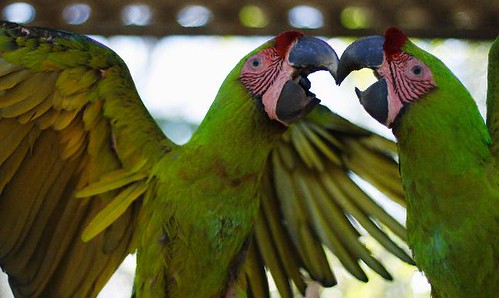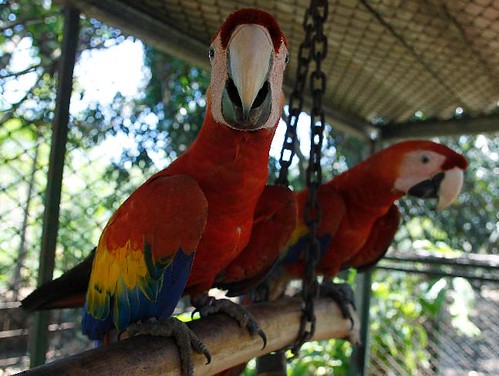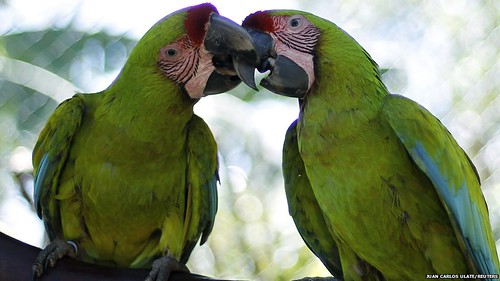 Two great green macaws play at a nursery of the ARA Project in Alajuela. Photo: Juan Carlos UlateThe majestic macaw—a member of the parrot family—is truly an emperor among birds, and I thrill to each and every sighting while in Costa Rica.
Two great green macaws play at a nursery of the ARA Project in Alajuela. Photo: Juan Carlos UlateThe majestic macaw—a member of the parrot family—is truly an emperor among birds, and I thrill to each and every sighting while in Costa Rica.
This tiny Central American nation has two of the New World’s 18 species of macaws: the Scarlet macaw (Ara macao, but called the lora in Costa Rica), found principally in on the Pacific lowlands; and the Great green macaw (Ara ambiguous), or Buffon's macaw, found within Costa Rica only in the Caribbean and northern lowlands.
The Great green macaw was reduced to only about 50 breeding pairs a decade ago and was well on its way to extinction. In the 1980s a concerted effort to save it was launched, centered on protecting the almendro trees on which the bird depends exclusively for feeding and nesting. Together with breeding and release programs, the result has been a significant increase in its population.
The Scarlet macaw population, which was reduced just two decades ago to a few pockets (principally around the Osa Peninsula, and Carara and Santa Rosa national parks), has also been rebounding thanks to conservation efforts.
 Two Scarlet Macaws rest at a nursery of the ARA Project in Alajuela. Photo: Juan Carlos UlateSeveral conservation groups are working to breed green and scarlet macaws for reintroduction to the wild in an effort to reestablish viable populations of these critically endangered birds and to link up the various isolated populations.
Two Scarlet Macaws rest at a nursery of the ARA Project in Alajuela. Photo: Juan Carlos UlateSeveral conservation groups are working to breed green and scarlet macaws for reintroduction to the wild in an effort to reestablish viable populations of these critically endangered birds and to link up the various isolated populations.
Asoprolapa
Based at the Barceló resort at Tambor, in the southern Nicoya Peninsula, this organization breeds Scarlet macaws for release. The first birds were freed in 2007 after 10 years of experimentation and research, and almost 100 birds have been released to date.
The Ara Project
The largest of Costa Rica’s macaw-breeding programs, this facility was initiated three decades ago by U.S. retirees Richard and Margot Frisius at their home at Río Segundo de Alajuela (three kilometers southeast of Alajuela). They renamed their home Finca Hatched to Fly Free and fitted it with huge aviaries and flyways. Today, the breeding center has expanded and is now in a separate three-hectare facility, funded by new benefactors, the Beirute family, and tended by a dedicated staff. Visitation ($20) is strictly by appointment. A study has warned that the Great Green Macaw, a native species of Costa Rica, is being endangered by deforestation.The first scarlet macaws were released in January 1999 at a private reserve in Nicoya. Dozens of scarlet macaws have since been released at Tiskita, near Pavones; about 85 percent have survived, and the various released populations are intermingling. Additional releases are planned near Dominical and in southwest Nicoya. The first captive-bred green macaws were released in 2011. Donations are needed, as are volunteer workers.
A study has warned that the Great Green Macaw, a native species of Costa Rica, is being endangered by deforestation.The first scarlet macaws were released in January 1999 at a private reserve in Nicoya. Dozens of scarlet macaws have since been released at Tiskita, near Pavones; about 85 percent have survived, and the various released populations are intermingling. Additional releases are planned near Dominical and in southwest Nicoya. The first captive-bred green macaws were released in 2011. Donations are needed, as are volunteer workers.
Zoo Ave
This private zoo at La Garita, west of Alajuela, also has a macaw breeding program and to date has released more than 100 macaws in Piedras Blancas National Park, in Golfo Dulce. It has successfully bred both the scarlet and the green macaw, as well as curassow, guan, and about 50 other native bird species with the help of a human-infant incubator. The breeding center is off-limits.